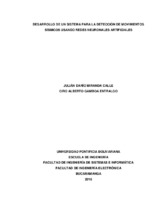Mostrar el registro sencillo del ítem
Desarrollo de un sistema para la detección de movimientos sísmicos usando redes neuronales artificiales
| dc.contributor.advisor | Flórez Abril, Angelica | |
| dc.contributor.advisor | Altuve Paredes, Miguel Alfonso | |
| dc.contributor.author | Miranda Calle, Julián Darío | |
| dc.contributor.author | Gamboa Entralgo, Ciro Albert | |
| dc.coverage.temporal | 2018 | |
| dc.date.accessioned | 2020-07-15T18:58:01Z | |
| dc.date.available | 2020-07-15T18:58:01Z | |
| dc.date.issued | 2018 | |
| dc.identifier.uri | http://hdl.handle.net/20.500.11912/5725 | |
| dc.description | 249 páginas | spa |
| dc.description.abstract | Este proyecto plantea el desarrollo de un sistema para la detección de movimientos sísmicos mediante el uso de redes neuronales artificiales. Se inicia con una contextualización en el ámbito sismológico y de aprendizaje automático que incluye características y atributos de las señales sísmicas y características de los procesos de clasificación, complementando los conceptos con una revisión de los antecedentes, evidenciando la implementación de técnicas de aprendizaje de máquina en la clasificación y detección sísmica. Posteriormente, se define la población muestral que comprende eventos sísmicos históricos de la Red Sismológica Nacional de Colombia (RSNC), dentro de la cual se extrae una muestra que es usada para el desarrollo modular del sistema. Este desarrollo está enmarcado en una metodología Ágil Scrum y de Prototipado. El flujo modular inicia con el análisis de las estaciones de mayor relevancia con el fin de reducir el costo computacional y de procesamiento, seguido del preprocesamiento de los datos (filtrado, normalización y re-muestreo), la extracción de atributos, y las etapas de entrenamiento, validación y prueba del clasificador binario desarrollado. Los atributos fueron extraídos sobre ventanas de 200 muestras de 5.144 eventos de las estaciones BRR, RUS, PAM y PTB de la RSNC con epicentro en Santander, en un periodo comprendido entre el 2015 y el 2017. Al unificar los módulos del último prototipo funcional y ejecutar las pruebas de validación cruzada al clasificador, se obtiene un modelo generalizable que clasifica los eventos sísmicos con un 99.21% de exactitud. | spa |
| dc.description.abstract | This project proposes the development of a system for the detection of seismic movements using artificial neural networks. It begins with a contextualization in the seismological and Machine Leaming environment. This includes characteristics and attributes of the seismic signals and characteristics of the classification processes. The concepts are complemented with a review of the background, showing the implementation of Machine Leaming techniques for seismic classification and detection. Subsequently, the sample population that includes historical seismic events of the National Seismological Network of Colombia (RSNC) is defined, within which a sample that is used for the modular development of the system is extracted. This development is framed in an Agile Scrum and Prototyping methodology. The modular flow begins with the analysis of the most relevant stations to reduce the computational and processing costs. Then a preprocessing of the data (filtering, normalization and re-sampling) is carded out, followed by the extraction of attributes, and the training, validation and testing stages. The attributes DOP, RV2T, entropy, kurtosis and asymmetry were extracted on 200 samples windows of 5144 events from the RSNC stations: BRR, RUS, PAM and PTB with epicenter in Santander, between 2015 and 2017. By performing the cross-validation tests to the classifier, a generalizable model that classifies the seismic events with a 99.21./. accuracy is obtained. These results agree with what was reported by lbs-Von Seht, et. al., who obtained a 97% accuracy in the classification with data between 2005 and 2007 from Indonesia, and Hasan, et. al., who obtained 90% accuracy in the classification with data between 2013 and 2014 from Morocco. | eng |
| dc.format.mimetype | application/pdf | |
| dc.language.iso | spa | |
| dc.publisher | Universidad Pontificia Bolivariana | spa |
| dc.rights | Attribution-NonCommercial-NoDerivatives 4.0 International | * |
| dc.rights.uri | http://creativecommons.org/licenses/by-nc-nd/4.0/ | * |
| dc.title | Desarrollo de un sistema para la detección de movimientos sísmicos usando redes neuronales artificiales | spa |
| dc.type | Trabajo de grado | spa |
| dc.publisher.department | Escuela de Ingenierías | spa |
| dc.publisher.program | Ingeniería de Sistemas e Informática | spa |
| dc.publisher.program | Ingeniería Electrónica | spa |
| dc.type.hasVersion | publishedVersion | spa |
| dc.description.sectional | Bucaramanga | spa |
| dc.description.degreename | Ingeniero de Sistemas e Informática | spa |
| dc.description.degreename | Ingeniero Electrónico | spa |
Ficheros en el ítem
Este ítem aparece en la(s) siguiente(s) colección(ones)
-
Trabajos de grado [6691]
Monografías, artículos, informes, proyecto de grado


